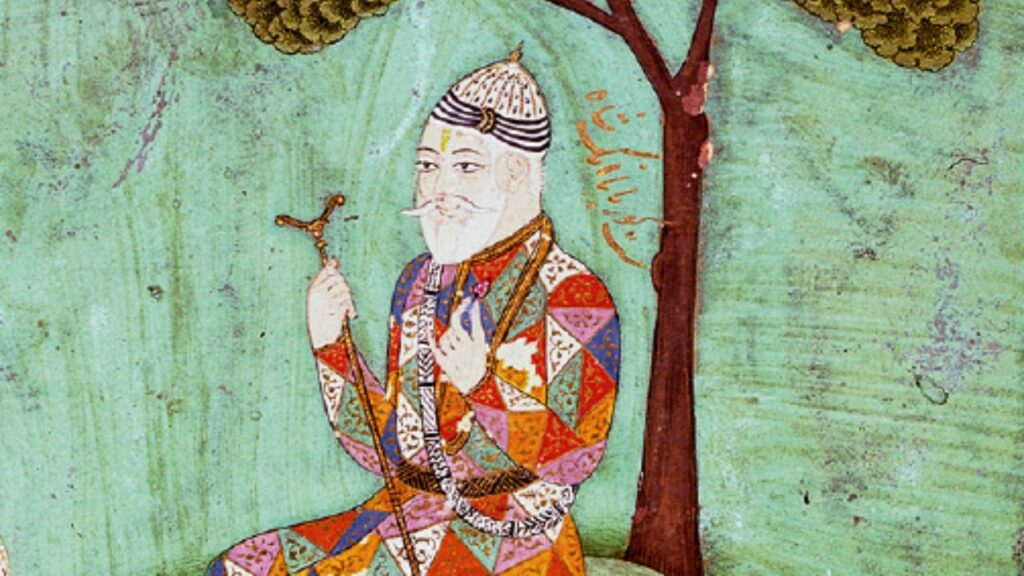10 gurus: A timeline of one of the youngest world religions

Sikhism, founded in the late 15th century in the Punjab region of South Asia, is based on the teachings of 10 Sikh Gurus, whose leadership and wisdom shaped the spiritual, social, and cultural landscape of the Sikh community for about two-and-a-half centuries beginning in 1469. Here’s a brief overview of each one:
1. Guru Nanak Dev Ji (1469–1539)
Guru Nanak Dev Ji (pictured above), is the founder of Sikhism and was born in 1469 in Nankana Sahib (now Pakistan). He emphasized the oneness of God, the importance of devotion, equality, and selfless service. Guru Nanak rejected the rigid rituals of contemporary Hinduism and Islam and introduced a new path of spirituality based on the teachings of love, equality, and compassion.
2. Guru Angad Dev Ji (1504–1552)
Guru Angad Dev Ji, the second Guru, succeeded Guru Nanak in 1539. He is credited with developing the Gurmukhi script, which became the standard script for writing the Punjabi language. Guru Angad focused on promoting education, physical well-being, and devotion to God. He also established the practice of “Langar” (community kitchen) to encourage selfless service and equality.
3. Guru Amar Das Ji (1479–1574)
Guru Amar Das Ji, the third Guru, expanded the concept of social equality by challenging caste distinctions. He promoted the importance of service, humility, and devotion, and established the “Manji” system for spreading Sikh teachings. Guru Amar Das also introduced the practice of “Anand Karaj” (Sikh marriage ceremony) and solidified the tradition of Langar.
4. Guru Ram Das Ji (1534–1581)
Guru Ram Das Ji, the fourth Guru, founded the city of Amritsar, which became the spiritual center of Sikhism. He composed many hymns, which were later included in the Guru Granth Sahib, the central religious scripture of Sikhism. Guru Ram Das emphasized devotion to God and the importance of humility, service, and community.
5. Guru Arjan Dev Ji (1563–1606)
Guru Arjan Dev Ji, the fifth Guru, is credited with compiling the Adi Granth, the first edition of what would later become the Guru Granth Sahib. He also constructed the Golden Temple in Amritsar, which became the holiest site for Sikhs. Guru Arjan’s leadership was marked by his martyrdom, as he was tortured and executed by the Mughal Emperor Jahangir for refusing to convert to Islam, making him the first Sikh martyr.
6. Guru Hargobind Ji (1595–1644)
Guru Hargobind Ji, the sixth Guru, introduced the concept of “Miri-Piri,” symbolizing the integration of both spiritual and temporal authority. He advocated for the defense of Sikhism against oppression, and in doing so, he equipped Sikhs with weapons and established a military tradition within the Sikh community. Guru Hargobind also built the Akal Takht (the Throne of the Timeless One) in Amritsar, a key symbol of Sikh sovereignty.
7. Guru Har Rai Ji (1630–1661)
Guru Har Rai Ji, the seventh Guru, is remembered for his compassion, particularly for his efforts to protect nature and wildlife. He was a proponent of nonviolence and healing, establishing herbal medicine and spiritual care as integral parts of Sikh practice. Guru Har Rai was also dedicated to the well-being of the Sikh community and expanded its teachings.
8. Guru Har Krishan Ji (1656–1664)
Guru Har Krishan Ji, the youngest of the Sikh Gurus, became Guru at the age of five. Despite his youth, Guru Har Krishan showed immense wisdom and compassion, especially in his efforts to help those suffering from the smallpox epidemic in Delhi. He is remembered for his humility, kindness, and spiritual insight, and his brief but impactful leadership left a deep mark on Sikhism.
9. Guru Tegh Bahadur Ji (1621–1675)
Guru Tegh Bahadur Ji, the ninth Guru, is revered for his martyrdom in defense of religious freedom. He sacrificed his life when the Mughal Emperor Aurangzeb demanded that he convert to Islam. Guru Tegh Bahadur’s refusal to abandon his faith and his willingness to die for the protection of others’ religious rights made him a symbol of courage and sacrifice. His hymns, which emphasize devotion and righteousness, are included in the Guru Granth Sahib.
10. Guru Gobind Singh Ji (1666–1708)
Guru Gobind Singh Ji, the tenth and final Guru, is one of the most revered figures in Sikh history. In 1699, he founded the Khalsa, a collective body of initiated Sikhs committed to the principles of Sikhism, including equality, service, and the defense of truth. Guru Gobind Singh also composed the Dasam Granth and declared that after his death, the Guru Granth Sahib would be the eternal Guru, marking the end of the line of human Gurus. He was a warrior, a poet, and a spiritual leader, and his teachings have had a profound impact on the development of Sikh identity and resilience.



